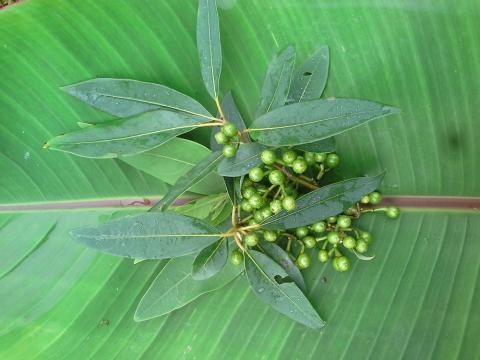
Litsea is a bit off the beaten path for some folks. Those familiar with Traditional Chinese Medicine, however, will know that Litsea (or May Chang) has been used medicinally for thousands of years. Native to Southeast Asia, Litsea has been used for everything from asthma to digestive issues. The tree is a food source for silk worms, and the silk made from worms that feed on Litsea is much higher in value than silk produced from other food sources. The stem bark, leaves, twigs, and fruits of Litsea species have all been traditionally used in various parts of Asia for a wide variety of health issues.
The scent of Litsea, steam distilled from the pepper-like fruit of the tree Litsea cubeba, has some resemblance to Lemongrass, Citronella and Palma Rosa. This isn’t surprising when you consider that they all share chemistry in the form of the aromatic components geraniol, citrol, and nerol. This similarity in and of itself is interesting because it shows how nature doesn’t like wasted effort. The same aromatics function in plants from completely different families: Litsea in the Laurel family, Lemongrass and Palma Rosa in the Grass family, and Citronella in the Cardiopteridaceae family. (Yes, a new name may be in order for that last one…)
Here are just some of the multitude of Litsea uses.
Litsea For Digestion
Litsea can be used diluted in olive oil as a belly rub for nausea, indigestion, gas, and discomfort. Its effects are strong enough to lend some comfort even to those with more serious issues such as Crohn’s Disease.
Litsea For Respiratory Health
Aside from antimicrobial properties helpful for supporting respiratory infections, Litsea dilates the bronchial tubes and reduces airwave spasms, helping to ease coughs associated with cold, flu, bronchitis, and asthma.
Litsea For Skin Care
While Litsea may cause skin sensitization for some folks, it’s used for a variety of skin conditions and for cleansing the pores. Litsea is often used for oily skin, acne, and blemishes. It’s an effective addition to natural deodorants and will help keep pesky mosquitoes from biting you. Try a small patch test on the inside of your elbow before using Litsea-based products on your skin if you tend to be reactive. And remember to dilute your essential oils before using them on the skin.
Litsea For Allergies
Litsea may be useful for anaphylaxis, due to its particular collection of diterpene molecules. The oil has an immunosuppressive effect on certain immune cells and reduces contact hypersensitivity reactions. I’m certainly not saying to toss your epi pen, but if you do have severe food allergies, you might consider carrying this oil with you. Litsea’s bronchiodilating activity helps here. Though I’m usually allergy-free, I had a full body reaction to something several years ago. It was serious enough for my partner to drive me to Urgent Care. Before heading out the door, I popped a Benadryl and, while waiting for it to kick in, sniffed some Litsea for the reaction and for the accompanying anxiety attack.
Litsea For Mood
Litsea helps with anxiety, as you might have guessed from the previous anecdote. It’s also an energizing oil, good for feelings of sluggishness. I was introduced to Litsea in an aromatherapy class. The class was subdued after sniffing the heavily sedating oil, Manuka. After the Litsea made its way around to everyone, the energy in the room shifted from low key to high energy, with students giggling and chatting.
So, give this oil a try if it’s one you’re not familiar with. Litsea’s lovely, lemony scent is a great addition to your perfumery supplies as well as your medicine cabinet.








